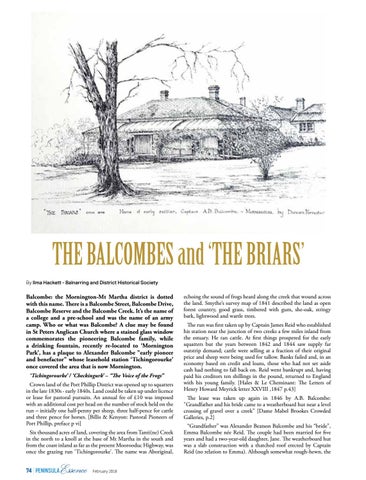THE BALCOMBES and ‘THE BRIARS’ By Ilma Hackett - Balnarring and District Historical Society
Balcombe: the Mornington-Mt Martha district is dotted with this name. There is a Balcombe Street, Balcombe Drive, Balcombe Reserve and the Balcombe Creek. It’s the name of a college and a pre-school and was the name of an army camp. Who or what was Balcombe? A clue may be found in St Peters Anglican Church where a stained glass window commemorates the pioneering Balcombe family, while a drinking fountain, recently re-located to ‘Mornington Park’, has a plaque to Alexander Balcombe "early pioneer and benefactor" whose leasehold station ‘Tichingorourke’ once covered the area that is now Mornington. ‘Tichingorourke’ / ‘Checkingurk’ – “The Voice of the Frogs” Crown land of the Port Phillip District was opened up to squatters in the late 1830s - early 1840s. Land could be taken up under licence or lease for pastoral pursuits. An annual fee of £10 was imposed with an additional cost per head on the number of stock held on the run – initially one half-penny per sheep, three half-pence for cattle and three pence for horses. [Billis & Kenyon: Pastoral Pioneers of Port Phillip, preface p vi] Six thousand acres of land, covering the area from Tanti(ne) Creek in the north to a knoll at the base of Mt Martha in the south and from the coast inland as far as the present Moorooduc Highway, was once the grazing run ‘Tichingorourke’. The name was Aboriginal,
E ssence
74 | PENINSULA
February 2018
echoing the sound of frogs heard along the creek that wound across the land. Smythe’s survey map of 1841 described the land as open forest country, good grass, timbered with gum, she-oak, stringy bark, lightwood and wattle trees. The run was first taken up by Captain James Reid who established his station near the junction of two creeks a few miles inland from the estuary. He ran cattle. At first things prospered for the early squatters but the years between 1842 and 1844 saw supply far outstrip demand; cattle were selling at a fraction of their original price and sheep were being used for tallow. Banks failed and, in an economy based on credit and loans, those who had not set aside cash had nothing to fall back on. Reid went bankrupt and, having paid his creditors ten shillings in the pound, returned to England with his young family. [Hales & Le Cheminant: The Letters of Henry Howard Meyrick letter XXVIII ,1847 p.43] The lease was taken up again in 1846 by A.B. Balcombe: "Grandfather and his bride came to a weatherboard hut near a level crossing of gravel over a creek" [Dame Mabel Brookes Crowded Galleries, p.2] “Grandfather” was Alexander Beatson Balcombe and his “bride”, Emma Balcombe née Reid. The couple had been married for five years and had a two-year-old daughter, Jane. The weatherboard hut was a slab construction with a thatched roof erected by Captain Reid (no relation to Emma). Although somewhat rough-hewn, the
